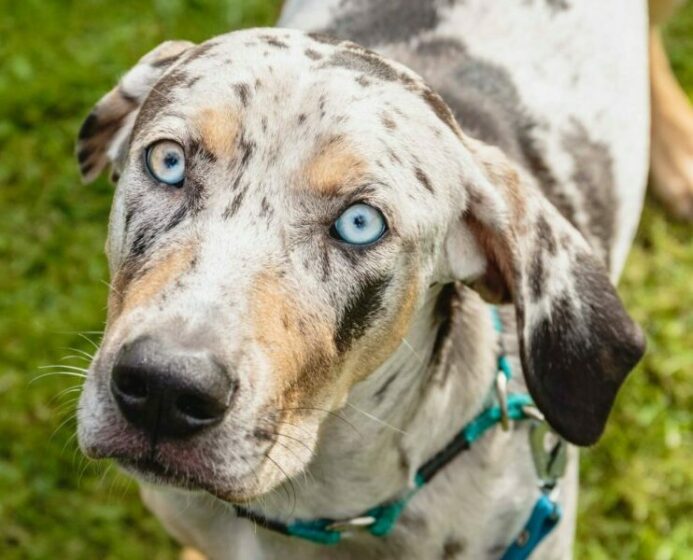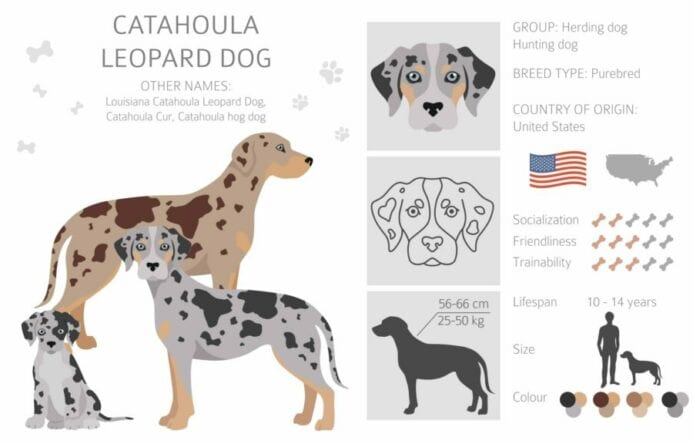
Catahoula Leopard dogs make great companions for those who appreciate rare and striking-looking dogs. Affectionate and hardworking, Catahoulas bond with their owners and make loyal protectors.
If you’re looking for a unique and courageous dog, consider adding a Catahoula Leopard Dog to your family.
Though they may seem strong and independent, they benefit from a firm hand during training. With patience and love, your Catahoula will quickly become a cherished family member.
If you’re looking for a working dog who will never fail to amaze you with its energy, the Louisiana Catahoula Leopard Dog may be your breed.
They typically need a strong leader to guide and train them, but once they develop a connection with their humans, they’ll try to show affection in every way possible.
Since this breed does best in bigger places, those with fenced yards or larger houses often adopt them.
Scroll down to learn more about this unusual breed.
Catahoula Leopard Dog history
The Catahoula’s rich history originated in Louisiana, near Catahoula Lake. This breed is believed to be a product of breeding Greyhounds, Mastiffs, and Bloodhounds.
This breed was initially used for herding and rounding up wild hogs. Also called Catahoula hog dogs, over time, the Catahoula Leopard Dog became its official name.
Several associations preserve and protect the breed, including the Louisiana Catahoula Cur Association, Catahoula Cur Breeders Association, American Catahoula Association, and the National Association of Louisiana Catahoulas.
The breed is the state dog of Louisiana.
Breed characteristics

These large dogs have short to medium-length hair that lies close to the body. The single coat can have a texture that ranges from coarse to smooth.
Since this breed doesn’t have long fur, it only requires occasional grooming. The dogs need weekly brushing to help control shedding and keep its coat looking shiny and clean.
In addition, the Catahoula has a broad skull with perfect cheekbones. It also has a long snout with a normal bite and bright blue eyes
This medium-large breed dog can range from 50 to 95 pounds. With this weight, this breed can reach up to 24 inches.
The dogs have various coat coloring, including spots, merle, patched, blue, grey, red, white, tan, chocolate, liver, and buff.
However, many people avoid adopting a merle-colored Catahoula Leopard Dog as they are more prone to deafness. Another unique feature of this breed is its eye color — each dog has eyes of a different color.
Catahoula Leopard Dogs make great pets for active families. They are loyal and affectionate but can also be severe and intense.
They will get along well with other animals and people if you socialize them early. Just be aware that they may show aggression towards dogs of the same sex.
Training tips
Training a Catahoula can be challenging because this energetic breed requires consistent training and socialization to thrive.
Start early
It’s essential to begin training your Catahoula as soon as possible, ideally when they are still puppies, to establish good habits and prevent unwanted behaviors like barking and digging from developing.
Be firm yet gentle
Strike the right balance between firmness and gentleness. The dogs respond to positive reinforcement techniques such as praise, treats, and playtime.
It’s also crucial to set boundaries and enforce rules calmly but assertively.
Socialize your dog
Catahoulas have strong protective instincts and can be wary of strangers or other animals if not properly socialized.
Exposing your dog to different people, places, and situations when young is essential to teach them how to interact appropriately.
Keep it short
These dogs have high energy levels and can become easily bored with long training sessions.
For better results, keep training sessions short (about 10-15 minutes) but frequent throughout the day.
Teach basic commands first
Before moving to more advanced tricks or skills, make sure your Catahoula has mastered basic commands like “sit,” “stay,” “come,” and “heel.”
Be patient
Training a Catahoula may take longer than other breeds due to their independent nature and high energy levels.
Be patient with your dog and remain calm and consistent.
Use a firm tone
Catahoulas responds well to a confident and assertive tone. They may not take your commands seriously if you sound unsure or hesitant.
Be consistent
Consistency is vital when training any dog, but particularly for Catahoulas.
Ensure everyone in the home uses the same commands and techniques to avoid confusing your dog.
Seek professional help
If you need help training your Catahoula or additional guidance, feel free to seek professional help from a certified dog trainer.
Loyal and protective
Catahoula Leopard Dogs are known for their fierce loyalty and protective nature towards their owners, making them excellent companions and guard dogs.
One of the key characteristics that contribute to the loyal nature of Catahoulas is their pack mentality. These dogs are highly social animals that thrive in a close-knit family environment.
Once they become part of your household, they will consider you as their pack leader and will do anything to please you and keep you safe. This bond between owner and dog is unbreakable, making them fiercely loyal companions.
In addition to being loyal, these dogs are protective of their owners.
Their strong instinct to guard comes from their history as working dogs who had to protect livestock from predators or intruders on the farm. This temperament trait has been passed down through generations, making Catahoulas exceptional guardians.
However, it is crucial to note that this protective nature needs proper training and socialization from an early age. Without proper guidance, they may exhibit overprotective behavior that could be harmful or intimidating towards strangers or other animals.
Exercise needs
These highly energetic and athletic dogs require daily physical activity to maintain their physical and mental well-being.
Catahoulas were initially bred for hunting and herding, which means they have a high prey drive and energy levels.
They are known for their endurance, agility, and speed, making them ideal companions for outdoor activities such as hiking, running, or biking.
A typical adult Catahoula needs at least 60-90 minutes of intense daily exercise to stay happy and healthy.
Brisk daily walks or runs will meet your Catahoula’s exercise needs.
Apart from walks, engaging your Catahoula in mentally stimulating activities is equally important.
These intelligent dogs thrive on learning new skills and challenges. Some great options include obedience training, agility courses, tracking exercises, or fun games like hide-and-seek or fetch.
Providing opportunities for your Catahoula to socialize with other dogs is also crucial for their well-being.
This working breed is used to being part of a pack when hunting or herding cattle; hence the dogs enjoy having canine companionship. Organizing playdates with other friendly dogs can help fulfill your Catahoula’s social needs while also providing them with valuable exercise.
Leaving a Catahoula alone for extended periods can lead to destructive behaviors due to boredom or pent-up energy.
Therefore, if you work long hours away from home, ensure you have someone to take your dog out for a walk or provide enough exercise and mental stimulation before leaving.
Tailor your Catahoula’s exercise routine to their age, health, and individual needs.
While younger Catahoulas have boundless energy, older ones may require more low-impact activities such as swimming or gentle walks. Additionally, if your Catahoula has any health conditions, consult a veterinarian to determine the appropriate activity level for them.
Caring for your dog
Depending on your Catahoula Leopard Dog’s size, age, and build, you’ll need to adjust the amount of food you give them. As a general guide, 3 3/8 to 5 1/8 cups daily should be enough to keep your pup happy and healthy.
The dogs are hardy and typically live for 10 to 14 years, though their lifespans can be affected by living conditions, training, and diet.
Giving your dog quality food, regular training, and a loving home can help them enjoy a long and healthy life.
The healthy breed is generally healthy, but health complications can develop. Some dogs lose their hearing or develop canine hip dysplasia.
This breed is likely to develop deafness due to its gene for merle coloration. This gene is linked with deafness and can make a puppy lose hearing ability.
The Catahoula Leopard Dog is also likely to develop hip dysplasia. It’s a painful condition where the thigh bone doesn’t fit into the hip joint, causing arthritis and pain.
Should you adopt a Catahoula Leopard Dog?
If you’re undecided about which dog breed is right, consider the Catahoula Leopard Dog.
This breed is courageous and has a solid muscular build, making it ideal for families looking for a loyal and protective companion. They are territorial and make good guard dogs.
The family dogs also are easy to train and don’t require frequent grooming, meaning you’ll save time and money on care.
